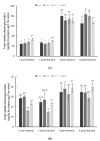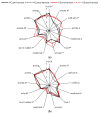Glycosylation of Volatile Phenols in Grapes following Pre-Harvest (On-Vine) vs. Post-Harvest (Off-Vine) Exposure to Smoke
- PMID: 34500710
- PMCID: PMC8433723
- DOI: 10.3390/molecules26175277
Glycosylation of Volatile Phenols in Grapes following Pre-Harvest (On-Vine) vs. Post-Harvest (Off-Vine) Exposure to Smoke
Abstract
Taint in grapes and wine following vineyard exposure to bushfire smoke continues to challenge the financial viability of grape and wine producers worldwide. In response, researchers are studying the chemical, sensory and physiological consequences of grapevine smoke exposure. However, studies involving winemaking trials are often limited by the availability of suitable quantities of smoke-affected grapes, either from vineyards exposed to smoke or from field trials involving the application of smoke to grapevines. This study compared the accumulation of volatile phenol glycosides (as compositional markers of smoke taint) in Viognier and Cabernet Sauvignon grapes exposed to smoke pre- vs. post-harvest, and found post-harvest smoke exposure of fruit gave similar levels of volatile phenol glycosides to fruit exposed to smoke pre-harvest. Furthermore, wines made from smoke-affected fruit contained similar levels of smoke-derived volatile phenols and their glycosides, irrespective of whether smoke exposure occurred pre- vs. post-harvest. Post-harvest smoke exposure therefore provides a valid approach to generating smoke-affected grapes in the quantities needed for winemaking trials and/or trials that employ both chemical and sensory analysis of wine.
Keywords: acid hydrolysis; guaiacol; smoke taint; syringol; wine.
Conflict of interest statement
The authors declare no conflict of interest. The funders had no role in the design of the study, i.e., in the collection, analysis or interpretation of data, in the writing of the manuscript or in the decision to publish the results.
Figures


References
-
- Krstic M.P., Johnson D.L., Herderich M.J. Review of smoke taint in wine: Smoke-derived volatile phenols and their glycosidic metabolites in grapes and vines as biomarkers for smoke exposure and their role in the sensory perception of smoke taint. Aust. J. Grape Wine Res. 2015;21:537–553. doi: 10.1111/ajgw.12183. - DOI
-
- Kennison K.R., Wilkinson K.L., Pollnitz A.P., Williams H.G., Gibberd M.R. Effect of timing and duration of grapevine exposure to smoke on the composition and sensory properties of wine. Aust. J. Grape Wine Res. 2009;15:228–237. doi: 10.1111/j.1755-0238.2009.00056.x. - DOI
-
- Kennison K.R., Wilkinson K.L., Pollnitz A.P., Williams H.G., Gibberd M.R. Effect of smoke application to field-grown Merlot grapevines at key phenological growth stages on wine sensory and chemical properties. Aust. J. Grape Wine Res. 2011;17:S5–S12. doi: 10.1111/j.1755-0238.2011.00137.x. - DOI
MeSH terms
Substances
Grants and funding
LinkOut - more resources
Full Text Sources

